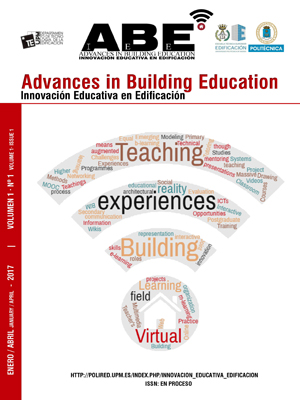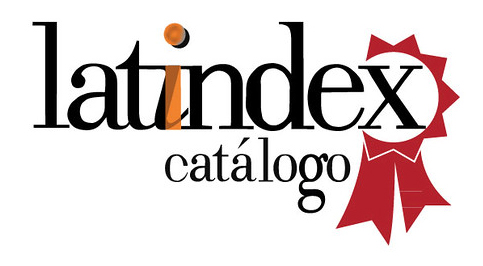Aplicación de la tecnología BIM en la asignatura de proyecto del Grado de Ingeniería Industrial en la UNEX = Application of BIM technology in the project subject of the industrial engineering degree in UNEX
DOI:
https://doi.org/10.20868/abe.2017.1.3513Keywords:
BIM, Educación, Universidad, Competencias, Education, University, Skills.Abstract
Resumen
Un gran número de estudios indican que la necesidad de profesionales con conocimientos BIM está sufriendo un rápido crecimiento. Este crecimiento está dando lugar a problemas en la implantación del BIM en el sector, siendo el principal de ellos la falta de formación de los técnicos en este ámbito [1-4]. Las enseñanzas universitarias actuales, se fundamentan en la adquisición de habilidades por parte del alumnado. En línea con las exigencias del Espacio Europeo de Educación Superior que denomina competencias a las habilidades a adquirir por el alumno. En este trabajo se trata de exponer la experiencia docente de la implantación de la tecnología BIM en la asignatura de proyectos. Esta asignatura tiene carácter obligatorio para las tres disciplinas del Grado de Ingeniería Industrial. El objetivo es deducir si el uso docente de la tecnología BIM facilita la adquisición de conocimientos y mejora la comprensión de la asignatura. La educación BIM debe centrarse en el desarrollo de los conocimientos básicos, habilidades y actitudes de los estudiantes [5]. Además, hay que enfatizar en la necesidad de que los técnicos de la industria de la construcción tengan habilidades como la colaboración, comunicación, liderazgo y la gestión de cambios, junto a habilidades técnicas relacionadas con BIM [6]. El mundo académico tiene un papel importante en la transformación de la industria impulsada por BIM [7]. Mientras que las entidades gubernamentales y el sector privado utilizan BIM para la nueva construcción, los programas universitarios han sido mucho más lentos en incorporar la tecnología [8]. Las universidades se están quedando detrás de la industria de la construcción en cuanto a la adopción de la tecnología BIM en la formación de los alumnos [9]. Realmente lo que se evalúa en este trabajo son precisamente los beneficios y dificultades que ha supuesto la implantación de la tecnología BIM en el desarrollo de la asignatura. Cuáles han sido los aspectos que ha mejorado y cuáles son los que se podrían mejorar.
Abstract
Many studies indicate that the need for professionals with BIM skills is undergoing a fast growth. This growth is giving rise to problems in the implementation of BIM in the sector: the main one is the lack of training of technicians in this area. The current university education is based on the acquisition of skills by students. In line with the requirements of the European Higher Education Area which calls competencies the skills to be acquired by the student. In this paper, the teaching experience of the implementation of BIM technology in the project subject is going to be explained. This subject is compulsory for the three disciplines of the Industrial Engineering Degree. The objective is to deduce if the teaching use of the BIM technology facilitates the acquisition of knowledge and improves the understanding of the subject. BIM education should focus on the development of basic knowledge, skills and attitudes of students. In addition, it is necessary to emphasize the need for construction industry technicians to have skills such as collaboration, communication, leadership and change management, along with technical skills related to BIM. The academic world plays an important role in transforming the industry driven by BIM. While government agencies and the private sector use BIM for new construction, university programs have been much slower in incorporating this technology. Universities are staying behind the construction industry in terms of adopting BIM technology in student training. Actually, the benefits and difficulties that has meant the implementation of BIM technology in the development of the subject is evaluated in this work: which aspects have improved and which aspects could be improved.
Downloads
References
Sacks R., Barak R. (2009). Teaching Building Information Modeling as an Integral Part of Freshman Year Civil Engineering Education, Journal of Professional Issues in Engineering Education and Practice: (ASCE). J Prof Issues Eng Educ Pract. 31;136(1):30–8.
Barison M.B., Santos E.T. (2015). The competencies of BIM specialists: a comparative analysis of the literature review and job ad descriptions, In: Proc, Int Workshop on Computing in Civil Engineering, ASCE, Reston, VA [Internet]. 2011 [cited 2015 Feb 18]. Available from:http://ascelibrary.org/doi/abs/10.1061/41182(41 6)73
Fridrich J., Kubečka K. (2014). BIM – The Process of Modern Civil Engineering in Higher Education, Procedia - Soc Behav Sci. 2014 Aug;141:763–7.
https://doi.org/10.1016/j.sbspro.2014.05.134
Sah V., Cory, C. (2008) Building Information Modeling: An Academic Perspective, Proceedings of The 2008 IAJC- IJME International Conference. ISBN 978-1- 60643-379-9. Purdue University. Paper 196, IT 301.
Sacks R., Pikas E. (2013). Building Information Modeling Education for Construction Engineering and Management. I: Industry Requirements, State of the Art, and Gap Analysis, J Constr Eng Manag. Nov; 139(11):04013016.
Gardner J.C., Hosseini M.R., Rameezdeen R., Chileshe N., (2014).Building Information Modelling (BIM) Education in South Australia, Industry Needs.
Suwal S., Jäväjä P., Rahman M.A., Gonzalez V. (2013). Exploring BIM-based education perspectives. AUBEA–2013 [Internet], [cited 2015 Jul 1]; Available from: https://www.library.auckland.ac.nz/external/final proceeding/Files/Papers/46530final00058.pdf
Sabongi F.J. (2009). The Integration of BIM in the Undergraduate Curriculum: an analysis of undergraduate courses, In: Proc, 45th Annual Conference of ASC [Internet]. [cited 2014 Mar 20]. Available from: http://ascpro0.ascweb.org/archives/2009/CEUE 90002009.pdf
Macdonald J.A., (2012). A framework for collaborative BIM education across the AEC disciplines, In: 37th Annual Conference of Australasian University Building Educators Association (AUBEA),Sydney, Australia [Internet]. 2012 [cited 2014 Oct 8]. Available from: http://resource.unisa.edu.au/file.php/588/Project_Publications/2012_Macdonald_AUBEA.pdf
Meadati P., Irizarry J. (2010). BIM–a knowledge repository, In: Proceedings of the 46th Annual International Conference of the Associated Schools of Construction, Retrieved November [Internet]. 2010 [cited 2014 May 20].
p.2010 Available from: http://ascpro0.ascweb.org/archives/cd/2010/pa per/CERT177002010.pdf
Almenara J.C. (2005). Las TICs y las Universidades: retos, posibilidades y preocupaciones, Rev Educ Super. 34(3):77– 100.
Smith P. (2014). BIM Implementation – Global Strategies, Procedia Eng. 2014;85:482– 92. https://doi.org/10.1016/j.proeng.2014.10.575
Rooney K. (2013). BIM Education- Global-Summary report–2013, NATSPEC Constr Inf. 2014;
MacDonald J., Mills J. (2013). An IPD approach to construction education, Australas J Constr Econ Build. 2013;13(2):93–103. https://doi.org/10.5130/ajceb.v13i2.3324
Becerik-Gerber B., Gerber D.J., Ku K. (2011). The pace of technological innovation in architecture, engineering, and construction education: integrating recent trends into the curricula, J Inf Technol Constr. 2011;16:411– 432.
Kocaturk T., Kiviniemi A. (2013). Challenges of Integrating BIM in Architectural Education. Proceedings of the 31st International Conference on Education and research in Computer Aided Architectural Design in Europe.
Gier D.M. (2015). Integrating Building Information Modeling (BIM) into Core Courses within a Curriculum: A Case Study, Int J Eng Res Gen Sci [Internet], [cited 2015 May 24];3(1). Available from: http://www.pnrsolution.org/Datacenter/Vol3/Issu e1/70.pdf
Checcucci É de S. (2014). Ensino- aprendizagem de BIM nos cursos de graduação em engenharia civil e o papel da expressão gráfica neste contexto, 2014;
Álvarez S., Cuéllar C., López B., Adrada C., Anguiano R., Bueno A., et al. (2011). Actitudes de los profesores ante la integración de las TIC en la práctica docente: estudio de un grupo de la Universidad de Valladolid, Edutec Rev Electrónica Tecnol Educ. (35).
Rodríguez-Izquierdo R.M. (2011). Repensar la relación entre las TIC y la enseñanza universitaria: problemas y soluciones, 2011 [cited 2016 Sep 21]; Available
Downloads
Published
Issue
Section
License
Copyright (c) 2021 Autor / BY-NC-ND

This work is licensed under a Creative Commons Attribution-NonCommercial-NoDerivatives 4.0 International License.
ABE (Advances in Building Education / Innovación Educativa en Edificación) does not charge authors for processing or publishing an article and provides immediate Open Access to its content. All content is available free of charge to the user or his institution. Users are permitted to read, download, copy, distribute, print, search or link to the full text of articles, or use them for any other lawful purpose, without prior permission from the publisher or author. This is in accordance with the BOAI definition of open access.
- Authors retain the copyright and grant to the journal the right to a Creative Commons attribution / Non-Commercial / Non-Derivative 4.0 International (CC BY NC ND) License that allows others to share the work with an acknowledgement of authorship and non-commercial use.
- Authors may separately establish additional agreements for the non-exclusive distribution of the version of the work published in the journal (for example, placing it in an institutional repository or publishing it in a book).
Unless otherwise indicated, all contents of the electronic edition are distributed under a Creative Commons license.














